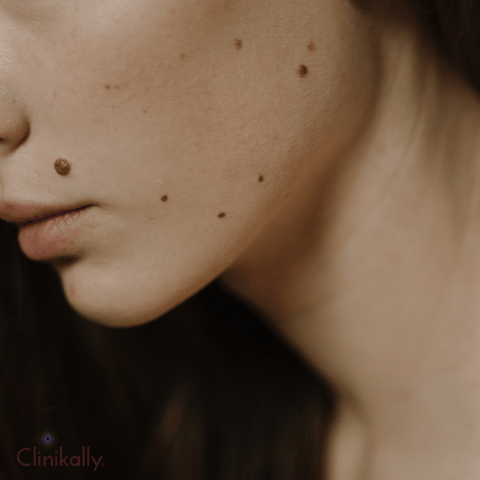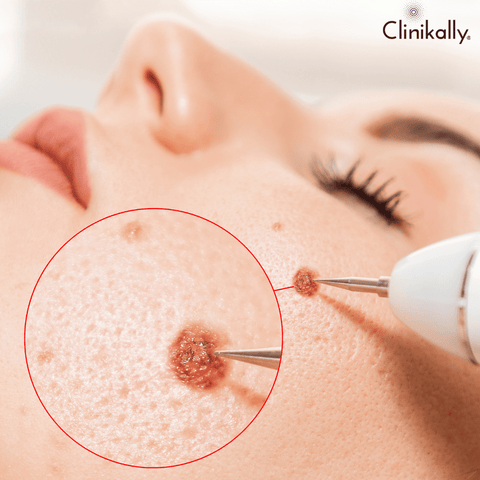What is the Difference between Beauty Marks And Moles? Unveiling the Truth!
Beauty marks and moles are both types of dark pigmentation on the skin, but beauty marks are generally smaller and considered more aesthetically pleasing, while moles can be larger and have a higher risk of developing into a health concern. Everyone has unique features on their skin, and some of these features may include beauty marks or moles.
While they may appear similar at first glance, there are important differences between the two. Beauty marks, also known as beauty spots or melanocytic nevi, are small dark patches on the skin that are often considered attractive and appear in various shapes and sizes.
On the other hand, moles are larger than beauty marks and can vary in color, shape, and texture. There can be a higher risk associated with moles, as they have the potential to develop into skin cancer. Understanding the differences between beauty marks and moles is crucial for monitoring any changes in the skin and ensuring overall skin health.

Credit: www.clinikally.com
Understanding Beauty Marks
The Nature Of Beauty Marks
Beauty marks are small, dark areas on the skin that are usually harmless.
Characteristics Of Beauty Marks
- Beauty marks are often flat and round in shape.
- They can vary in color from brown to black.
- Beauty marks are usually smaller than moles.
Understanding Moles
The Nature Of Moles
Moles are clusters of pigmented skin cells, often appearing brown or black.
These growths can vary in size, typically smaller than a pencil eraser.
Most moles are harmless, but changes in size, shape, or color may need medical attention.
Characteristics Of Moles
- Moles are generally round or oval-shaped.
- They are often flat or slightly raised on the skin.
- The color can range from light brown to dark black.
- Moles may appear alone or in clusters.
- Most moles stay unchanged over time.
Distinguishing Features
Differentiating Beauty Marks And Moles
Understanding the dissimilarity between beauty marks and moles is essential for anyone seeking to know more about their skin. Each has unique characteristics that set them apart, and recognizing these traits can aid in proper identification.
Recognizing Unique Traits
When it comes to distinguishing beauty marks from moles, it’s important to note the varying traits that characterize each. By examining factors such as size, shape, color, and texture, individuals can differentiate between the two with confidence.
Associated Myths
Beauty marks and moles are often mistaken for each other, but they have distinct differences. Beauty marks are small, dark spots on the skin that are considered attractive, while moles are usually larger and can vary in color and texture.
Beauty marks, also known as beauty spots or moles, are small colored spots on the skin that are often considered attractive or charming. However, there are several myths and misconceptions associated with these distinctive features.
Myths Surrounding Moles
Moles, on the other hand, are small, dark spots on the skin that are usually harmless but can sometimes indicate underlying health concerns. Let’s take a look at some common myths surrounding both beauty marks and moles:
Dispelling Misconceptions About Beauty Marks
- Beauty marks are not caused by picking or scratching the skin. They are usually present at birth or develop during puberty due to a concentration of pigmented cells.
- Contrary to popular belief, beauty marks are not contagious. You cannot “catch” a beauty mark from someone else.
- Despite the name, beauty marks are not limited to just women. Men can also have beauty marks, and they can be found on any part of the body.
- Having a beauty mark does not mean you are more prone to skin cancer. While it’s important to monitor any changes in your beauty marks, most of them are harmless.
- There is no scientific evidence to support the notion that beauty marks have any significant impact on a person’s personality or character.
Myths Surrounding Moles
- Having a mole does not necessarily mean you have an increased risk of skin cancer. Most moles are harmless and do not require any medical intervention.
- Contrary to popular belief, moles do not always grow or change shape. Many moles remain the same throughout a person’s lifetime.
- You cannot remove a mole by cutting it off yourself. Removing a mole should be done by a qualified medical professional to avoid complications.
- The presence of a mole does not indicate that a person has poor hygiene or is unclean. Moles are a natural part of the skin’s pigment cells.
- All moles are not cancerous. If you notice any changes in the size, shape, or color of a mole, it’s important to consult a dermatologist for proper evaluation.
By dispelling these myths, we can gain a better understanding of beauty marks and moles, and appreciate them for what they truly are – unique features that make each individual beautiful in their own way.
Medical Insights
Beauty marks and moles are often used interchangeably, but there are key differences in their medical significance. Let’s explore the distinct characteristics and medical implications of beauty marks and moles.
Medical Significance Of Beauty Marks
Beauty marks, also known as melanocytic nevi, are benign growths on the skin. They usually arise from an overgrowth of pigment-producing cells called melanocytes. Beauty marks are considered harmless and are typically small, flat, and well-defined.
They are generally non-cancerous and do not require medical treatment unless there are changes in size, shape, or color. Some beauty marks can be cosmetically appealing and are often referred to as “beauty spots.”
- Usually small, flat, and well-defined
- Considered harmless and non-cancerous
- No medical treatment required unless changes occur
Medical Significance Of Moles
Moles, medically known as melanocytic nevus, are also benign skin growths composed of melanocytes. Unlike beauty marks, moles can vary in size, shape, and color. They may protrude from the skin’s surface and have irregular borders.
Some moles may be present at birth or develop during childhood and adolescence. While most moles are harmless, individuals with a large number of moles or atypical moles may have an increased risk of skin cancer and should undergo regular skin examinations.
- Varies in size, shape, and color
- May protrude from the skin’s surface
- Some may be present at birth or develop later

Credit: www.clinikally.com
Cultural Significance
Historical Perceptions Of Beauty Marks
Throughout history, beauty marks have been associated with notions of attractiveness and charm. In ancient times, these marks were often considered as unique adornments that added an air of mystique and allure to individuals. They were often referred to as “beauty spots” and were strategically placed on the face to accentuate certain features, such as the cheek or lip. These marks were not only a fashion statement but also conveyed a sense of sophistication and elegance.
Cultural Beliefs About Moles
Contrary to beauty marks, moles have often been viewed differently across various cultures. While some cultures regard moles as symbols of beauty and individuality, others perceive them as omens of good or bad fortune. For instance, in Chinese culture, the position and characteristics of moles are believed to have significant implications for one’s destiny. Similarly, in Indian culture, moles are thought to signify different aspects of a person’s life, including wealth, health, and personality traits.
Beauty Standards
Beauty marks and moles may appear similar, but there are key differences between the two. Beauty marks are small, dark spots while moles can vary in color and size. Understanding these distinctions can help in determining the significance and treatment options for each.
beauty marksmolesbeauty standards:Influence Of Beauty Marks On Standards
Beauty marks, often positioned on the face, are generally praised in today’s beauty standards due to their association with charm and uniqueness.The Impact Of Moles On Beauty Perceptions
Moles, being more prevalent and larger in size than beauty marks, can sometimes affect beauty perceptions but are gradually being embraced in the beauty industry.
Credit: www.thedermspecs.com
Conclusion
In essence, knowing the disparities between beauty marks and moles can help you understand your skin better. Recognizing their unique features and understanding when to seek medical attention is crucial for maintaining healthy skin. By being informed, you can confidently navigate your skincare routine with the assurance of knowing what is and isn’t a cause for concern.